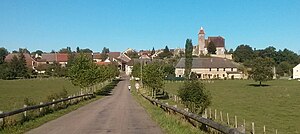Bussières (Haute-Saône)
| Bussières | ||
|---|---|---|
|
|
||
| region | Bourgogne-Franche-Comté | |
| Department | Haute-Saône | |
| Arrondissement | Vesoul | |
| Canton | Rioz | |
| Community association | Pays Riolais | |
| Coordinates | 47 ° 20 ′ N , 5 ° 58 ′ E | |
| height | 210-306 m | |
| surface | 6.11 km 2 | |
| Residents | 425 (January 1, 2017) | |
| Population density | 70 inhabitants / km 2 | |
| Post Code | 70190 | |
| INSEE code | 70107 | |
 Entrance |
||
Bussières is a commune in the French department of Haute-Saône in the region Bourgogne Franche-Comté .
geography
Bussières is located at an altitude of 223 m above sea level, about twelve kilometers north-northwest of the city of Besançon (as the crow flies). The village extends in the south of the department, on the northern edge of the valley plain of the Ognon , opposite Geneuille , at the southern foot of the forest heights of the Grands Bois.
The area of the 6.11 km² large municipal area includes a section of the middle Ognon Valley. The southern border always runs along the Ognon. This flows here with several turns to the west through an alluvial plain that is one to two kilometers wide and averages 215 m. The river banks are mostly flat, only in the area of the Grotte de la Baume on a bulging slope in the far east of the area they are accompanied on a short section of limestone rocks. From the course of the river, the community area extends northward over the valley level to the adjacent plateau, which is mainly used for agriculture. Further to the north are the heights of the Grands Bois , an extensive forest area. Here, at 306 m, the highest point of Bussières is reached. These mountain ranges consist of alternating layers of sandy, marly and calcareous layers from the Upper Jurassic period .
The neighboring communities of Bussières are Boult in the north, Voray-sur-l'Ognon and Chevroz in the east, Châtillon-le-Duc and Geneuille in the south and Boulot in the west.
history
Bussières was first mentioned in a document as early as 1174. In the Middle Ages, the village belonged to the Free County of Burgundy and in it to the area of the Bailliage d'Amont . The local rule over Bussières was held by the noble family of the same name, which has been documented since the 12th century. Together with Franche-Comté , the village finally came to France with the Peace of Nijmegen in 1678. Today Bussières is a member of the community association Communauté de communes du Pays Riolais, which comprises 33 villages .
Attractions
The village church of Bussières was built in the 18th century and has an altar and a tabernacle in the Louis XV style . The Château de Bussières dates from the 19th century. The Fontaine du Bas, a former fountain and cattle trough, has the shape of a semicircle, was built in 1819 and is one of the Monuments Historiques.
population
| Population development | |
|---|---|
| year | Residents |
| 1962 | 228 |
| 1968 | 195 |
| 1975 | 201 |
| 1982 | 272 |
| 1990 | 305 |
| 1999 | 283 |
After the population had decreased significantly in the first half of the 20th century (443 people were counted in 1881), from the beginning of the 1970s to 1990 the population continued to grow. Since then, however, a slightly downward trend has been observed again.
Economy and Infrastructure
Until well into the 20th century, Bussières was mainly a village characterized by agriculture (arable farming, fruit growing and cattle breeding) and forestry. Today there are some local small businesses. In the last few decades the village has transformed into a residential community. Many workers are therefore commuters who go to work in the larger towns in the area and in the Besançon agglomeration.
The place is off the major thoroughfares on a departmental road that leads from Voray-sur-l'Ognon to Étuz . The closest connection to the A36 motorway is around nine kilometers away. There are further road connections with Boult and Geneuille.
